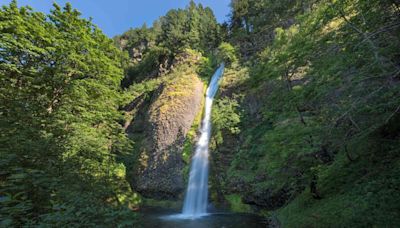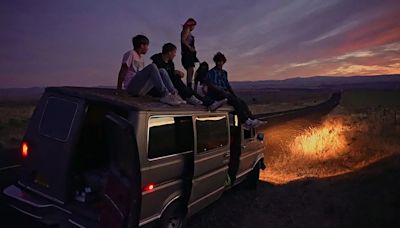Search results
This spot, Oregon City's Abernethy Green, marked the traditional End of the Oregon Trail. The pioneers first view of Oregon City contrasted sharply with the wild and deserted country they were leaving behind on the Trail.
- Missionaries Blaze The Oregon Trail
- Marcus Whitman
- Great Emigration of 1843
- Cayuse War
- Life on The Oregon Trail
- Oregon Trail Route
- Independence Rock
- Dangers on The Oregon Trail
- The End of The Oregon Trail
- Sources
By the 1840s, the Manifest Destiny had Americans in the East eager to expand their horizons. While Lewis and Clarkhad made their way west from 1804 to 1806, merchants, traders and trappers were also among the first people to forge a path across the Continental Divide. But it was missionaries who really blazed the Oregon Trail. Merchant Nathaniel Wy...
Determined to spread Christianityto American Indians on the frontier, doctor and Protestant missionary Marcus Whitman set out on horseback from the Northeast in 1835 to prove that the westward trail to Oregon could be traversed safely and further than ever before. Whitman’s first attempt took him as far the Green River Rendezvous, a meeting place f...
When Whitman headed west yet again, he met up with a huge wagon train destined for Oregon. The group included 120 wagons, about 1,000 people and thousands of livestock. Their trek began on May 22 and lasted five months. It effectively opened the floodgates of pioneer migration along the Oregon Trail and became known as the Great Emigration of 1843.
Upon Whitman’s return to his mission, his main goal shifted from converting American Indians to assisting white settlers. As more settlers arrived, the Cayuse resisted their encroachment. After a measles epidemic broke out in 1847, the Cayuse population was decimated, despite Whitman using his medical knowledge to help them. In the ongoing conflict...
Planning a five- to six-month trip across rugged terrain was no easy task and could take up to a year. Emigrants had to sell their homes, businesses and any possessions they couldn’t take with them. They also had to purchase hundreds of pounds of supplies including flour, sugar, bacon, coffee, salt, rifles and ammunition. By far, the most important...
It was critical for travelers to leave in April or May if they hoped to reach Oregon before the winter snows began. Leaving in late spring also ensured there’d be ample grass along the way to feed livestock. As the Oregon Trail gained popularity, it wasn’t unusual for thousands of pioneers to be on the path at the same time, especially during the C...
The settlers gave a sigh of relief if they reached Independence Rock—a huge granite rock in Wyoming that marked the halfway point of their journey—by July 4 because it meant they were on schedule. So many people added their name to the rock it became known as the “Great Register of the Desert.” After leaving Independence Rock, settlers climbed the ...
Many settlers looked at the Oregon Trail with an idealistic eye, but it was anything but romantic. According to the Oregon California Trails Association, almost one in ten who embarked on the trail didn’t survive. Most people died of diseases such as dysentery, cholera, smallpox or flu, or in accidents caused by inexperience, exhaustion and careles...
With the completion of the first transcontinental railroad in Utahin 1869, westward wagon trains decreased significantly as settlers chose the faster and more reliable mode of transportation. Still, as towns were established along the Oregon Trail, the route continued to serve thousands of emigrants with “gold fever” on their way to California. It ...
Life and Death on the Oregon Trail: Provisions for Births and Lethal Circumstances. Oregon California Trails Association. Marcus Whitman (1802-1847) Narcissa Whitman (1808-1847). PBS New Perspectives on the West. Oregon Donation Land Act. The Oregon Encyclopedia. Oregon or Bust. Arizona Geographic Alliance. Oregon Trail. The Oregon Encyclopedia. Tr...
- 3 min
Jan 13, 2023 · The End of the Oregon Trail Interpretive Center contains a wealth of displays about the history of the Oregon Trail and the town of Oregon City. Before heading into the center, explore the outside grounds and gardens.
Apr 2, 2019 · For three years this was the end of the Oregon Trail as an overland route. It was here, just past The Dalles, that the wagons were loaded on rafts or bateaux and floated down to Fort Vancouver and Oregon City.
People also ask
Where did the Oregon Trail End?
How long was the Oregon Trail?
When did Overland Trails End?
Where does the Oregon Trail go?
Apr 3, 2019 · April 3, 2019. Oregon Trail Chronology. For twenty five years, as many as 650,000 people may have pulled up stakes and headed for the farms and gold fields of the West. No accurate records exist of traffic on the great overland trails of that era, and some believe the figure may have been as low as 250,000 people.
The Oregon Trail was a 2,170-mile (3,490 km) east–west, large-wheeled wagon route and emigrant trail in the United States that connected the Missouri River to valleys in Oregon Territory. The eastern part of the Oregon Trail spanned part of what is now the state of Kansas and nearly all of what are now the states of Nebraska and Wyoming .







